Even though the title race is over in the Croatian top-flight, 1. HNL, and it may be not as tight and as nailbiting as the ones in the Premier League and they might not be as tactical as Serie A or positional as La Liga, they do have some incredible teams and players at their disposal. This tactical analysis will be a part of a series Toni Bilandžić and myself will be working on in the foreseeable future.
We aim to analyse all the 1. HNL’s teams’ tactics and present you with a complete and thorough overview of the league and its players. This week, the focus will be on Simon Rozman’s NK Rijeka who are currently second in the table and are probably the closest in quality to Dinamo Zagreb that Croatia has to offer.
Let’s dive straight into his philosophy.
Data analysis
Before we start with the detailed tactical analysis of the squad, performing a data analysis of the team, both on its own and within the league as a whole, will help us identify their style of play, key players as well as certain trends in Rožman’s tactics through statistics. The first graph below will tell us something about Rijeka’s preferred style of play by measuring whether they tend to rely on long or lateral balls.
The two styles we’ve identified below are direct and positional, depending on what kind of passes do the teams prefer. Quite clearly, Dinamo Zagreb and Rijeka are the teams that enjoy a possession-based build-up the most while lower-table teams generally tend to be more direct in their approach.
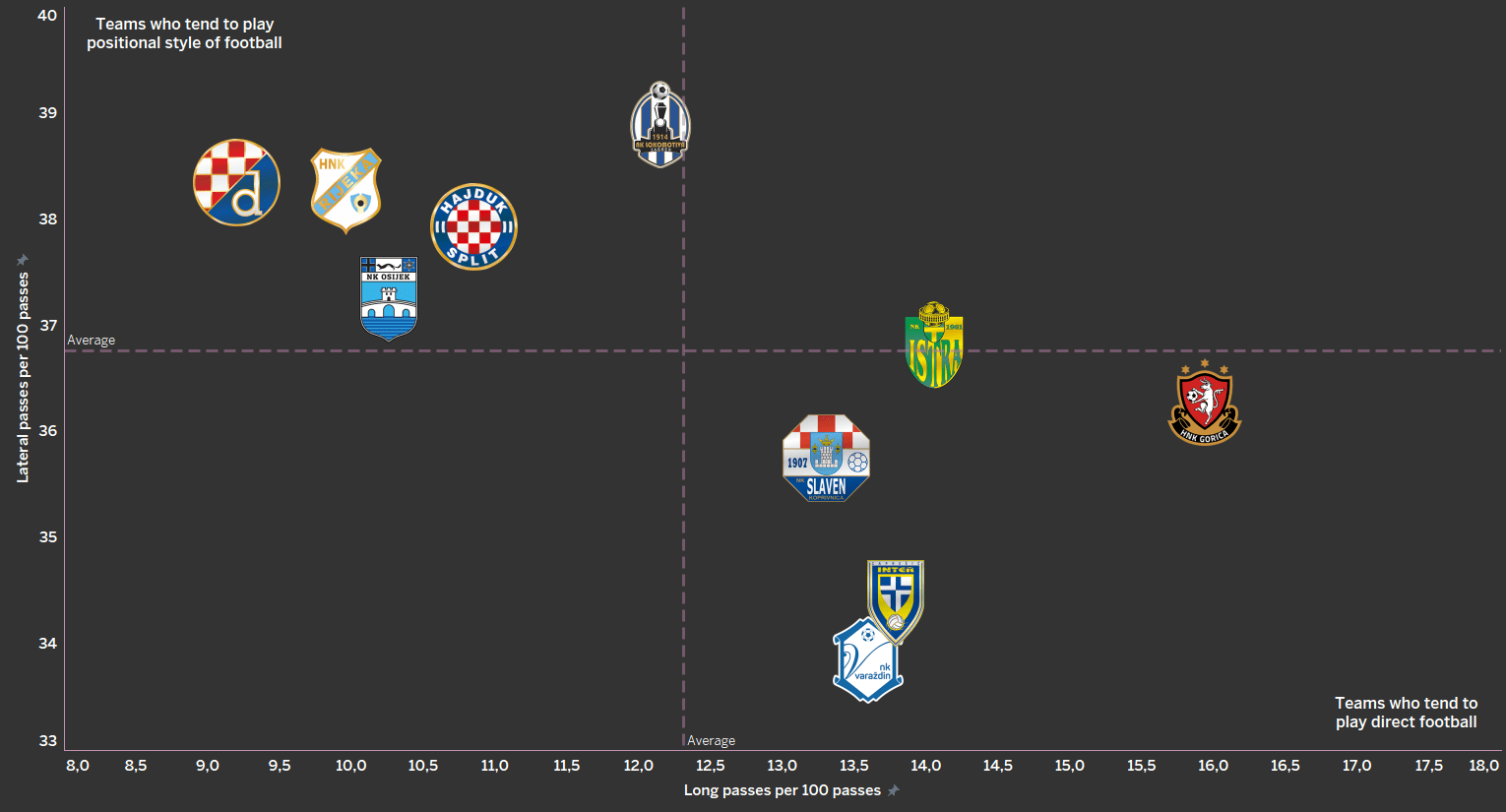
Next, we will take a look at their defensive style by measuring PPDA (passes allowed per defensive action) values and the average shot distance by the opponent in metres, which can be seen in the following graph. The graph differentiates between four main styles, depending on the values they recorded.
And looking at the graph, we can see that Rijeka have a mixed approach and while they generally force their opponent to shoot from distance, they will be aggressive according to the situation at hand. Sometimes, they will press high and at other times, they won’t mind sitting a bit deeper and being patient.
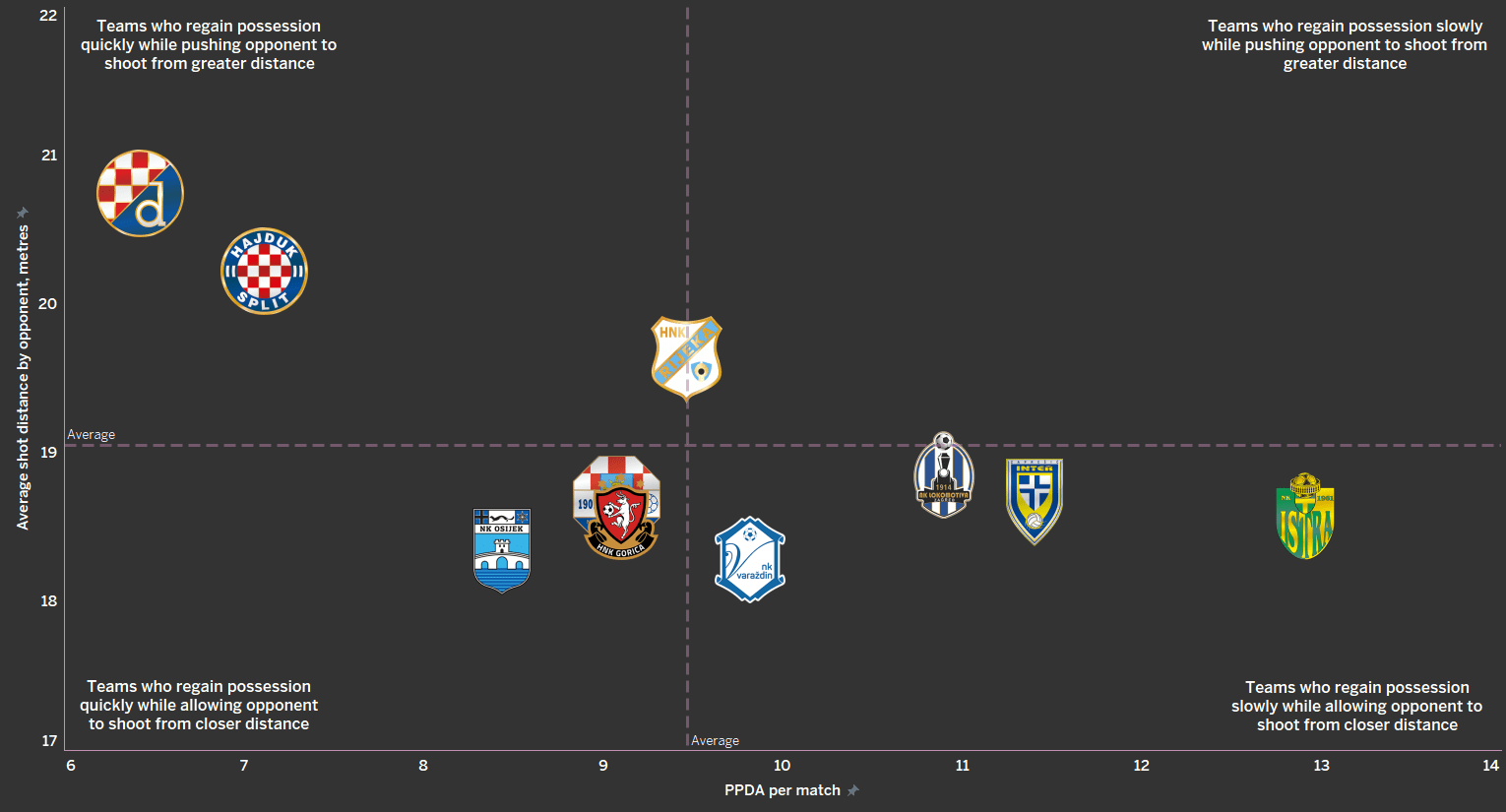
This has now given us a general overview of Rijeka’s attacking and defensive styles of play and with that out of the way, we can start identifying some of their key players in all phases of play. First off, Rijeka’s age profile with the age of all the players and the minutes they’ve played in the last calendar year.
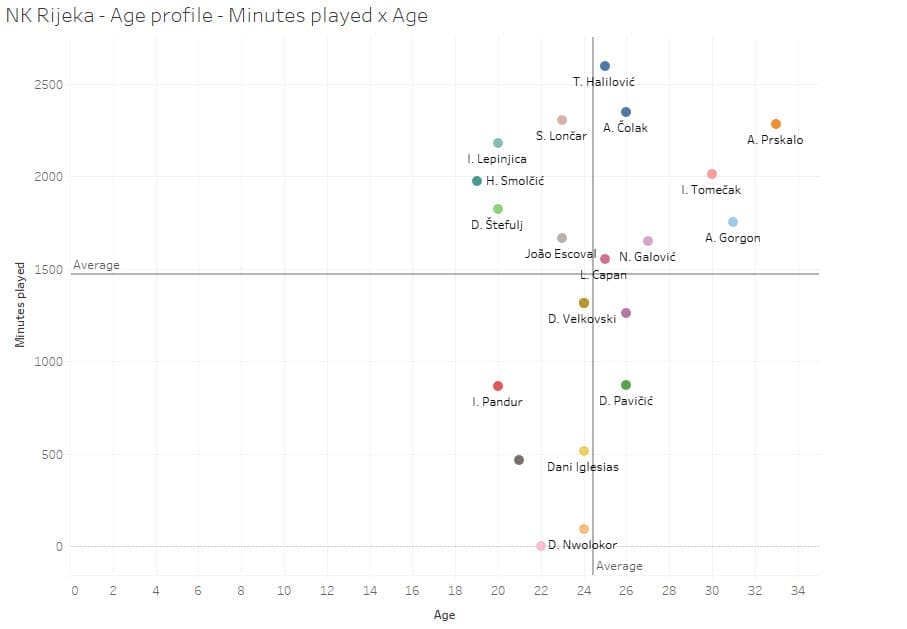
Immediately, we can see that their most important players are all either fairly young or approaching their prime years. The only players over the age of 30 are Gorgon, Tomečak and Prskalo while many who are in their early 20s have an above-average minute tally as well.
The following graph will measure their defensive duels won in % and their defensive duels per 90 minutes to show us the most efficient defenders in the squad in the last calendar year. Note, however, that the bigger the circle on these graphs, the more minutes the player has played and we’ll only make note of the players who have played a significant role in the team.
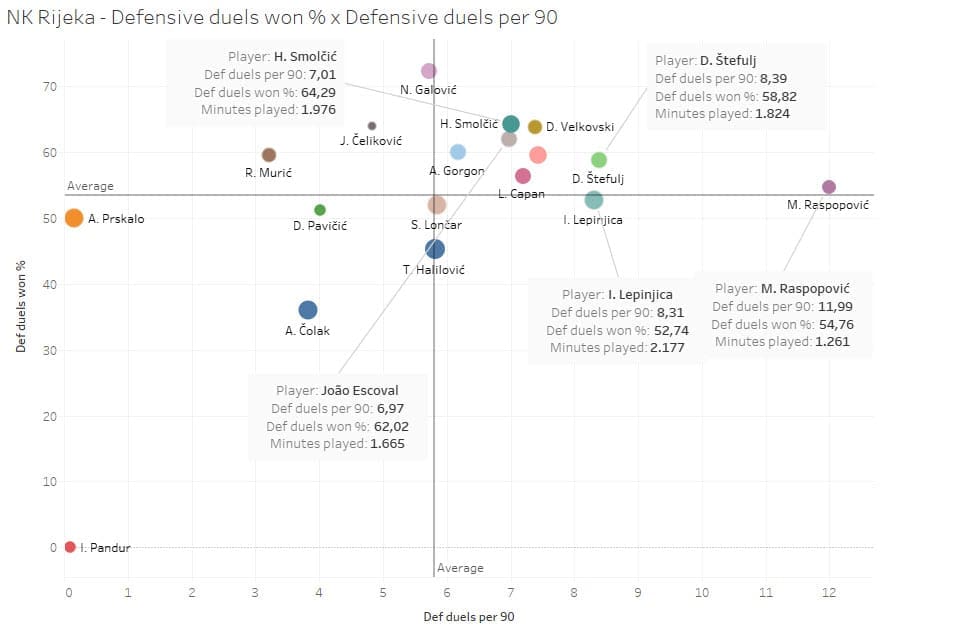
Even though we have highlighted some of the names in the scatter graph above, Rijeka seem to have many players who both engage in above-average tally defensive duels per 90 and also win a high % of them as well.
Momčilo Raspopović has a club-high number of defensive duels per 90 with 11.99 and wins 54.76% of them, which is also slightly over the average line of 53.85%. But all of Smolčić (7.01 and 64.29%), Štefulj (8.39 and 58.82%), Lepinjica (8.31 and 52.74%), Velkovski (7.39 and 63.89%) and Escoval (6.97 and 62.02) tally impressive figures here.
Next, we’ll make a note of their biggest threats in attack. First, we’ll measure their goal contribution per 90 (goals + assists) and expected goal contribution per 90 (expected goals + expected assists). Two names stand out from the crowd: Antonio Čolak and Robert Murić are in a world of their own with the former registering 0.73 goal contribution and 0.63 xGoal contribution and the latter 0.75 and 0.62 respectively, both overperforming their expected figures.
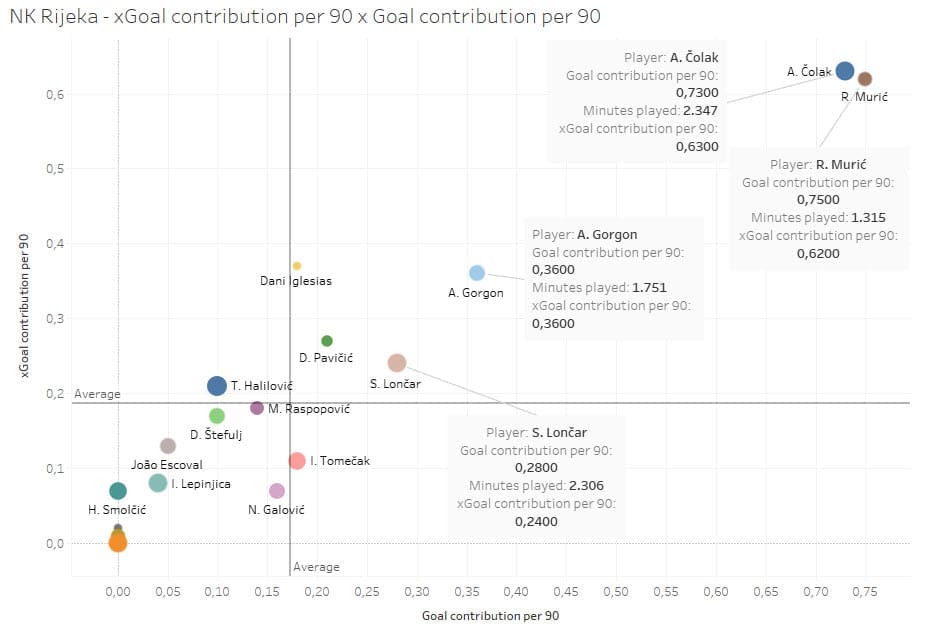
Lončar and Gorgon can also be mentioned but their impact still pales in comparison to the other two names. After that, we can assess the team’s creativity by taking note of their passes to danger area per 90 (passes to final third + passes to penalty area) and key passes per 90.
This time, Murić, Štefulj and Tomečak are names worth mentioning here as they tally impressive figures in both categories. Murić, however, is clearly leading the way with 1.03 key passes and 9.99 passes to danger area per 90 minutes.
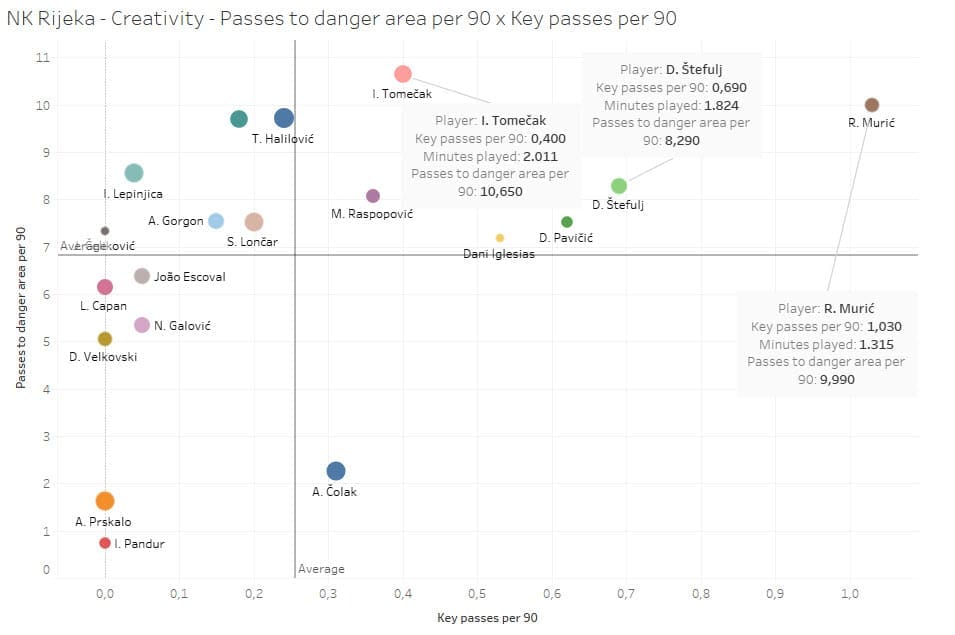
But who are the players who are the best at getting the ball forward with their runs, passes and/or dribbles? The following graph will answer that question.
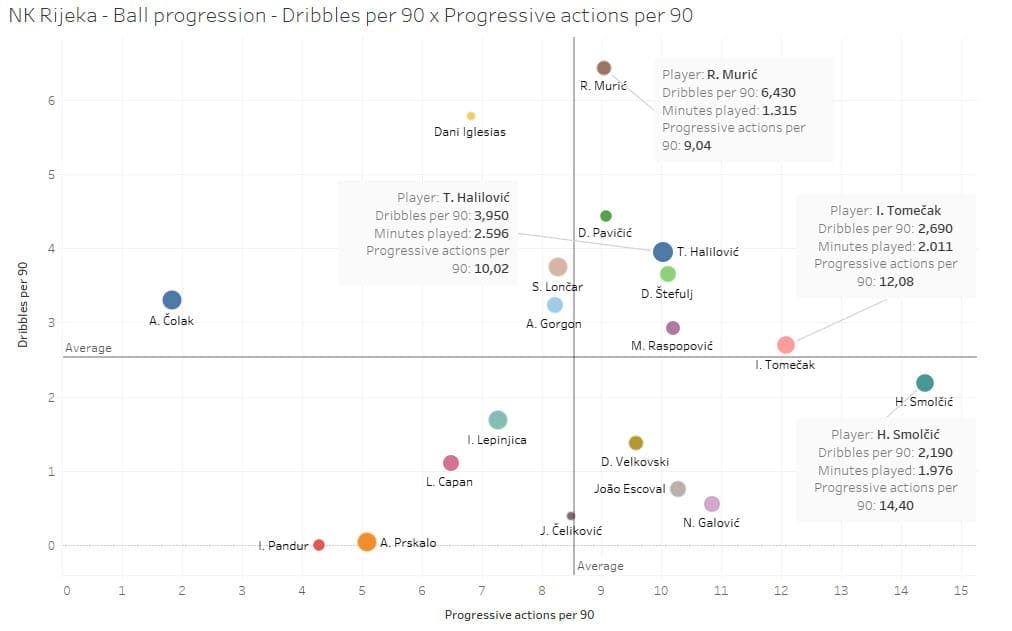
Once again, we can see familiar names like Murić and Tomečak, albeit on different sides of the graph – the former with a high volume of dribbles and the latter excelling at progressive actions. Smolčić seems to be the best progressor with 14.40 actions per 90 minutes and is followed by Tomečak’s 12.08.
And since Smolčić is here among Tomečak, both wide players, we can conclude that they do prefer to move the ball forward through the flanks and from the back.
Now that we have consulted the data to find their style of play in both attack and defence, as well as the key pieces of their squad, we can start dissecting their tactics in the following sections.
Build up and beating the press
Rijeka’s build-up phase under Rožman has definitely become one of the tactically most impressive and interesting concepts as the new coach seems to favour heavy positional play with lost of movement, numerical superiorities and combinations. Generally, however, Rijeka seem to favour the formation with three in the back in the first phase of their build-up play.
Their full-backs are practically wing-backs in the attacking phase and their usually form a line of four or five in midfield, depending on the opposition’s structure. But with three players in the back line and a dropping pivot, they can establish a numerical superiority over most of the teams who engage them in a higher press.
If the opposition press with a forward two, the three centre-backs will usually get the support of a single pivot dropping to avoid the press, as can be seen in our graphic down below.
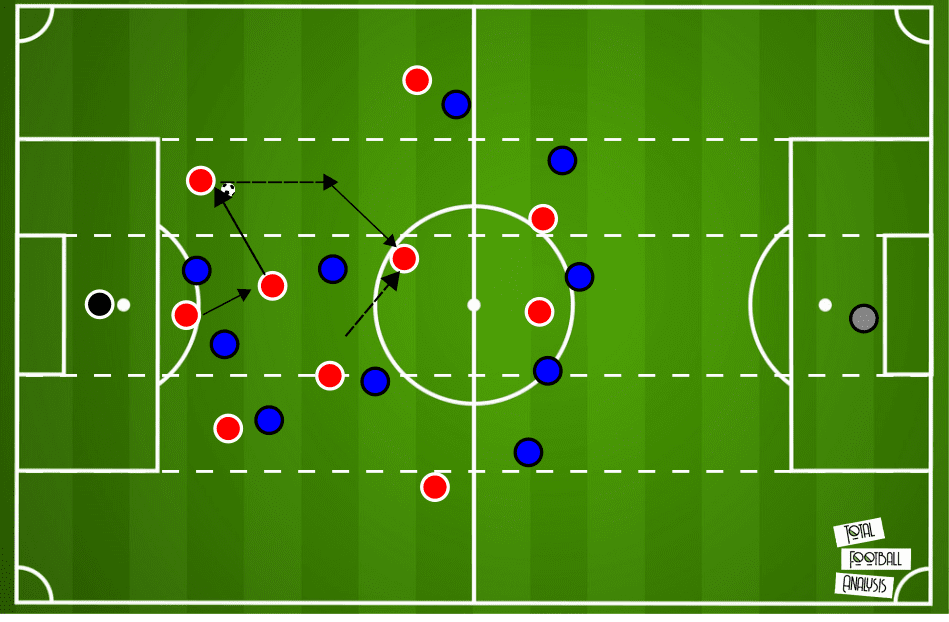
There are a couple of key things to notice in that sequence. Firstly, the opposition are pressing with a front two and as a result, they have to deploy a man from the second line to cover the right centre-back while the two forwards track the ball-carrier and cover shadow the left centre-back.
Secondly, notice how a midfielder has dropped deeper and is there immediately man-marked by the opposition midfielder. The same can be said for the midfielder right next to him who is also tightly marked. This, however, frees up the third player who moves out into the open space to receive the ball from his centre-back. Finally, the wing-backs and the forwards keep their markers pinned fairly high on the pitch and they are, therefore, unable to engage in the press.
We can see similar concepts when three players are pressing in the front line. Rijeka will then drop (at least) two midfielders to support the backline. We can see an example of that structure in the image below and against one of the most aggressive pressing sides in the league, Hajduk Split.
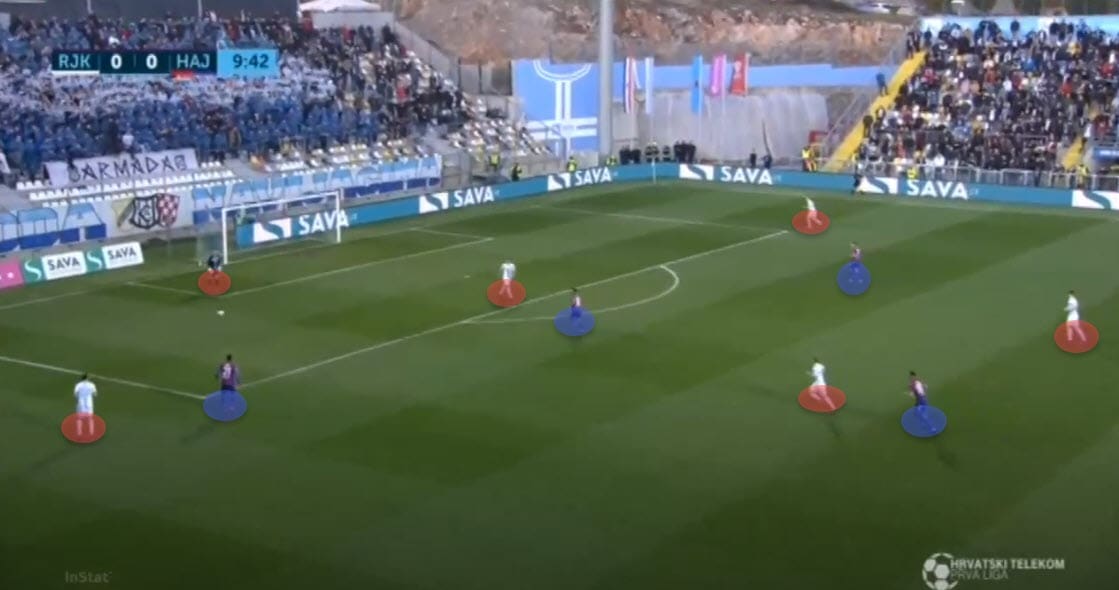
The back three are spread out to stretch the forward three and since Hajduk commit players from their second line, it leaves holes behind in the wider areas. But Pandur, the goalkeeper, has options in the dropping midfielders as Rijeka achieve numerical superiority in their half.
And these are the essential principles behind Rožman’s tactics – overloads and superiorities. Notice in another example below how they are ready to deploy nine men to combat Dinamo Zagreb’s seven-man pressing attempt and that opens up a channel that can be exploited directly from the backline.
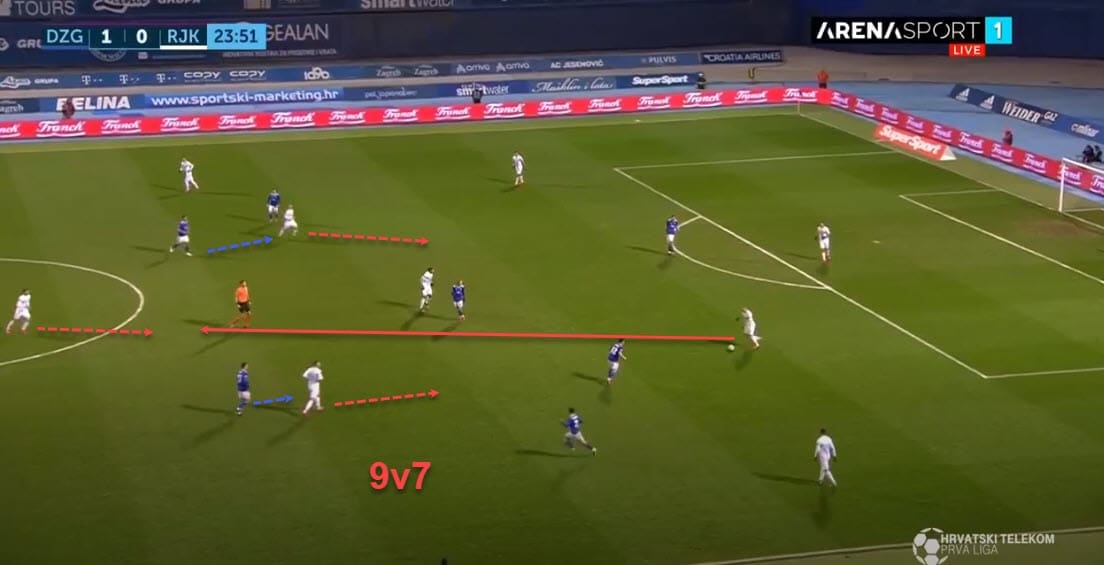
Let’s observe another example where they achieve overloads out wide to enable the ball progression through their wing-backs, who we know are one of their main progressors that we highlighted in the data analysis part of our piece.
Once again the opposition is trying to squeeze Rijeka out of possession but Rožman’s backline combines well with the dropping midfielder and the wide men to outplay their markers and send the ball out wide in a 4v3 situation.
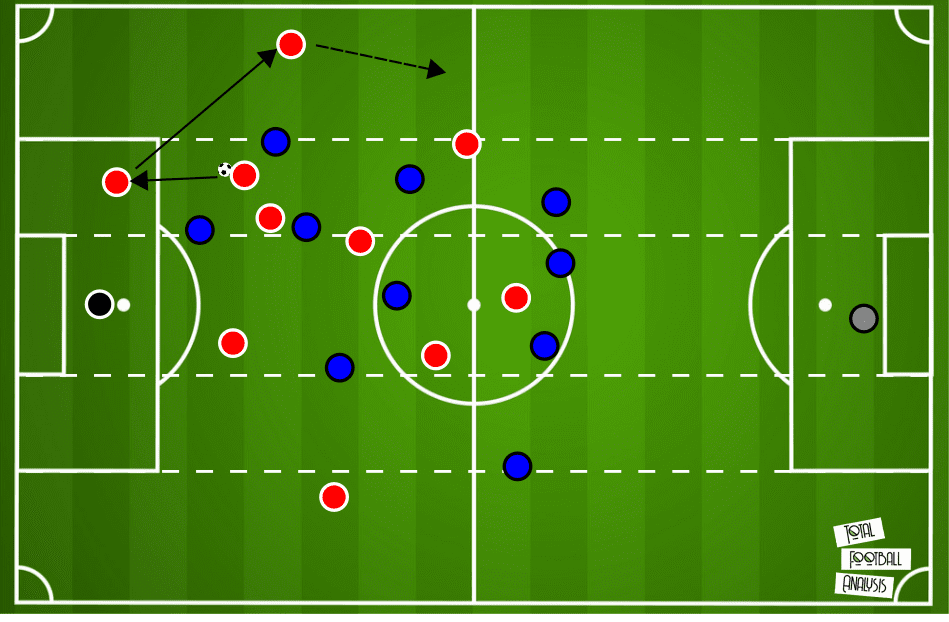
And this seems like a common pattern they exercise in the first phase of play quite often. Overload the opposition to free up the flank and then advance the ball down those channels. Like in the following example against Dinamo, who are the most aggressive pressing side in the league.
The Blues press Rijeka with three players on the right side but with numerical superiority and some movement manipulation, which we will talk about again further down the line of this tactical analysis, they manage to free up the wing-back and progress the attack with ease.
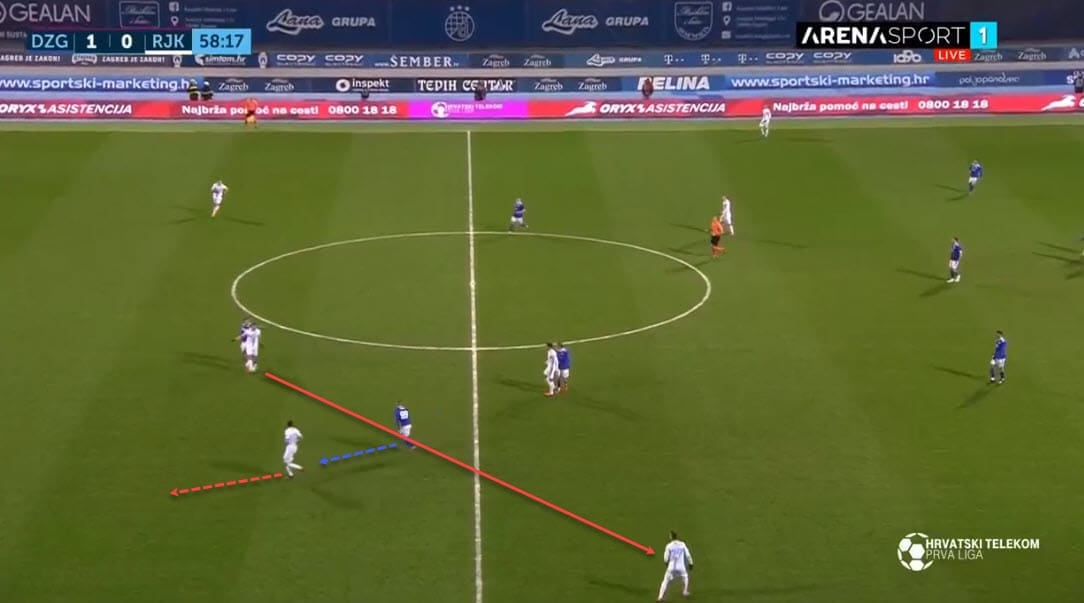
Finally, if all else fails, they still have the option of sending a long ball over the pressing opposition and into one of their forwards, usually Čolak or Gorgon, who act as target-men to quickly control and lay it off in the middle and final third of the pitch.
We can see an example of that below with a successful attempt against Osijek, another side that like to press quite high.
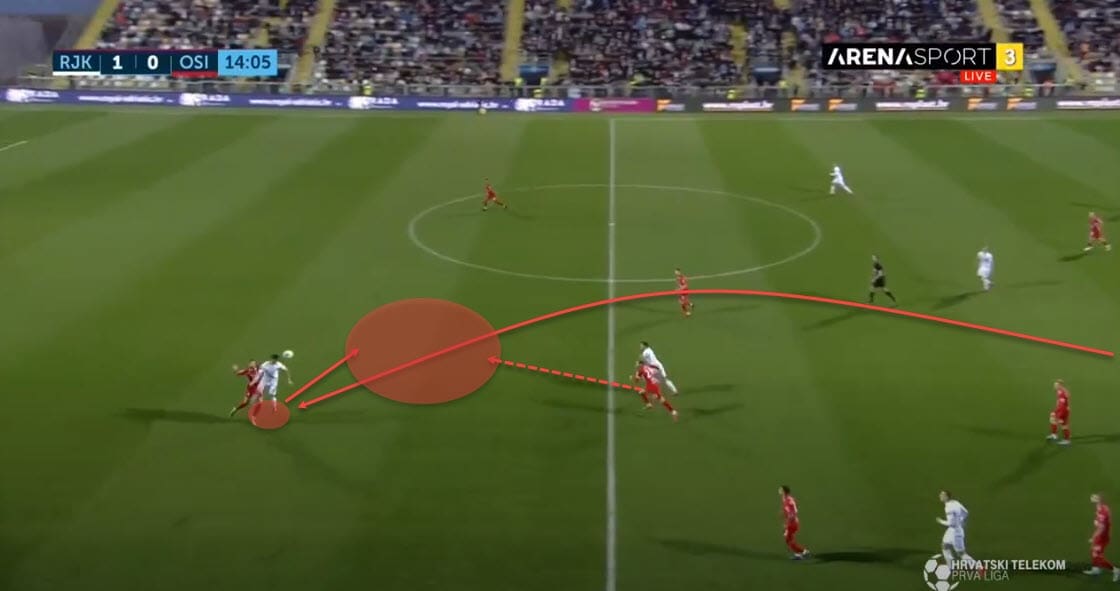
Final third movement and half-space exploitation
Rijeka usually play with two forwards and then get the width from their wing-backs. On paper, their attacking formation will often look something like a 3-5-2 or a 3-4-1-2 with an attacking midfielder, two strikers and full-backs who serve as wing-backs and even wingers when in possession.
But the main idea with their strikers is that they are usually extremely flexible and will often drop deep, drift wide and exchange positions to confuse the opposition’s backline. Čolak, who will be analysed in-depth later on this week, is especially effective in this role.
Let’s observe one such situation below with Rijeka in possession in the opposition’s half and looking to exploit the space in behind their defensive line. One of the forwards drops deeper, dragging his marker with him, and the other forward immediately darts into that space, waiting for the ball.
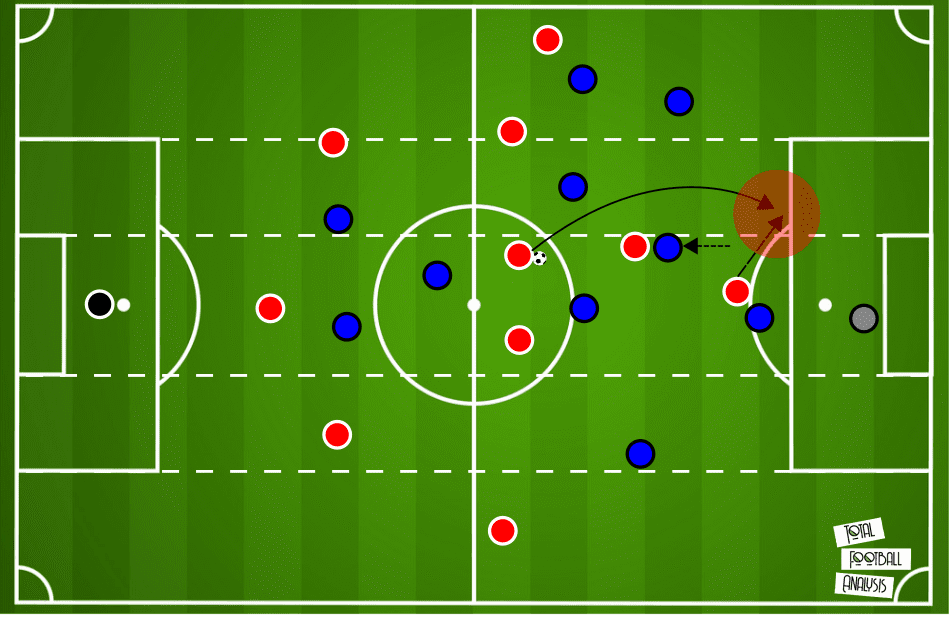
And unsurprisingly, he receives the pass moments later as a lofted ball over the top is sent into the open space behind the opposition’s backline. The movement of the forwards, therefore, is one of the key aspects in Rožman’s overall system.
For that reason, seeing them combine with their midfielders or wide players is not uncommon at all. They will drop off and lay the ball off to the flanks towards an overlapping player. Similarly, they will drop deeper and regardless whether they get the ball for a brief second or not, they will quickly dart back towards the box, tricking the defender who had followed them tightly. This is another dangerous weapon in Čolak’s arsenal that will be visited again soon.
And with that kind of tactical flexibility and freedom of movement in the final third, it doesn’t come as a surprise that they emphasise exploiting the half-spaces regularly when attacking. This can be seen both in a steady build-up or in transitional play, as we’ll see in the following examples.
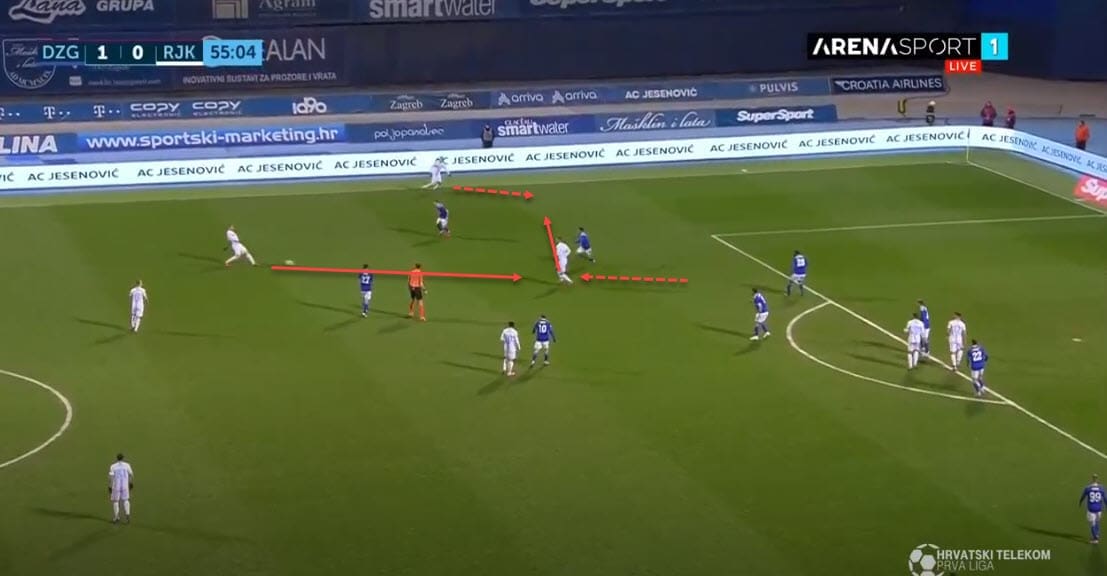
Above, we can see Rijeka’s structure against Dinamo Zagreb’s lower block and notice the slight dropping of one of the players into the half-space to receive the ball from the back. This attracts the attention of the opposition defenders who end up opening up space behind to be exploited.
A quick lay-off sends the wide player darting into space and into a good crossing position, which Rijeka ultimately fail to exploit. But it still showcases a great tactical move by Rožman’s men that managed to eliminate the defensive line with ease.
Let’s take a look at another example below, this time against a less-organised defensive structure of Osijek. Even though this is not a purely transitional example, it does show how a player dropping between the lines and into the half-space can kick the attack into higher gear immediately.
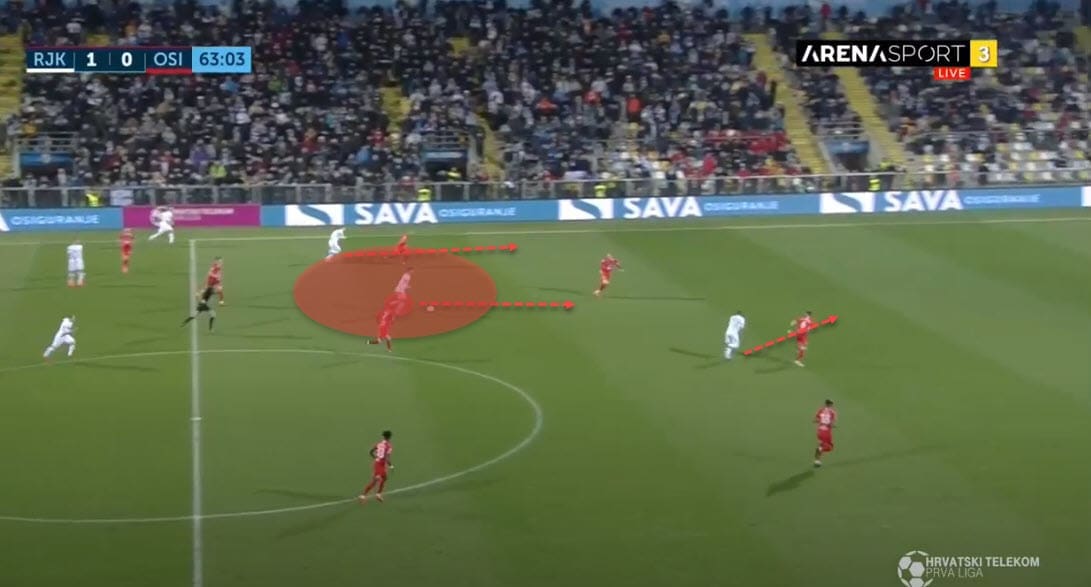
Osijek leave a lot of space and Rijeka advance the ball centrally and then out wide with a couple of simple touches that put their opposition into decisional problems – engage or stay back? Mark the forward, the ball-carrier or the wide man? Track your man or cover space?
This kind of movement can be extremely deadly when executed well and Rijeka tend to do exactly that.
Defensive style of play
With a PPDA (passes allowed per defensive action) value of 10.75 in the last calendar year and with the initial graphs in our data analysis at the beginning of the piece, we can conclude that while they are not the most aggressive of pressers, Rijeka still know how to keep the opposition away from their goal and are generally a good defensive side.
When out of possession, their 3-4-1-2 will shift into a 5-3-2 with the wing-backs dropping deep to make the five-man backline and the two forwards staying relatively high up the pitch. The numbers do suggest a more pragmatic approach but Rijeka practise a mix of high/ medium block and also zonal and man-marking systems.
Let’s take a look at a fairly usual structure below. Rijeka are in their 5-3-2 system out of possession and while the forward duo tracks the ball and tries to close the middle channels, the opposition try to shift out wide.
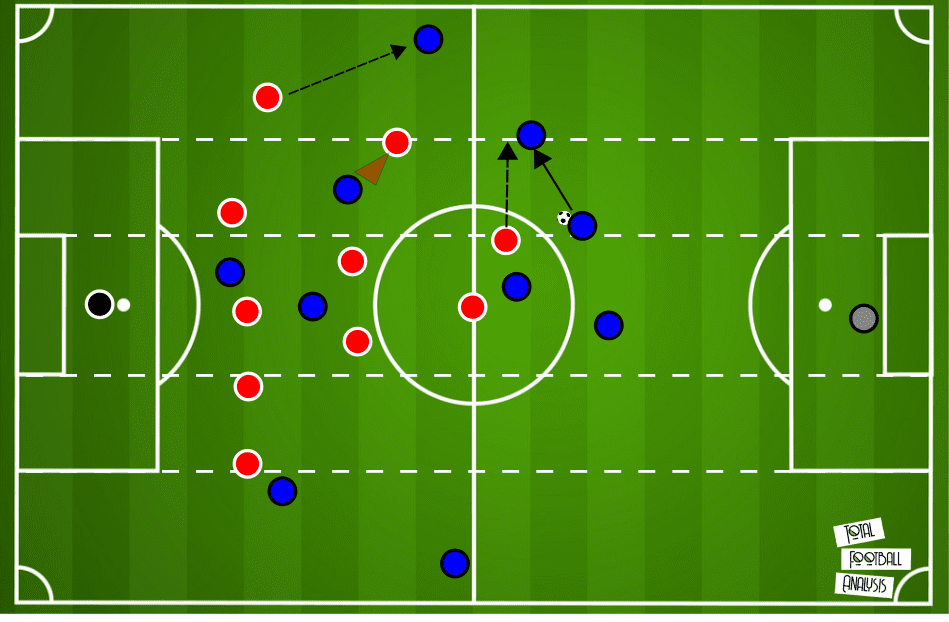
Notice how the midfielder won’t engage the full-back in this case but will continue to screen the opposition’s central options and will let his wide defender press instead. There is an interesting pattern that often comes out of this concept.
Once the wide defender engages the opposition’s full-back, the other defender will then change markers to accommodate for that movement out wide. This ensures the opposition’s forwards are always tightly marked and they don’t have to commit men from the second line, which would leave space open as a direct result of that.
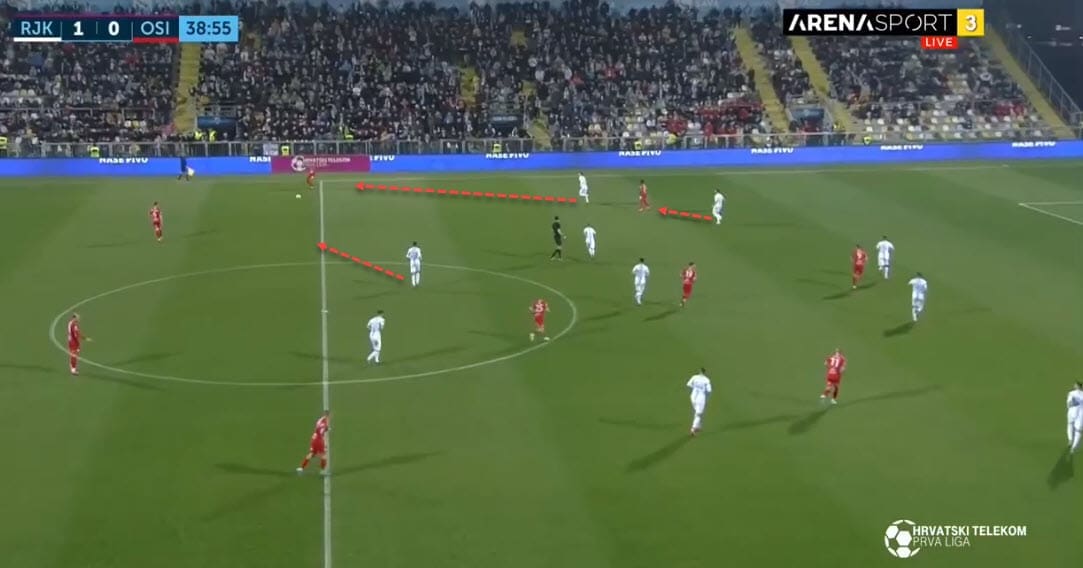
And more often than not, this will be their primary approach out of possession but that doesn’t mean they will never force turnovers and apply heavy pressure to the opposition. Generally, they seem to prefer to collapse when the other team is forced out wide and is hugging the touchline.
In those scenarios, they will try to suffocate them with numbers, leaving the forwards higher in case the ball can then quickly be transitioned into the final third and beyond. Note such an example below as Osijek have possession out wide but are quickly engaged by Rijeka who screen both their backline and midfield options to snatch the ball away.
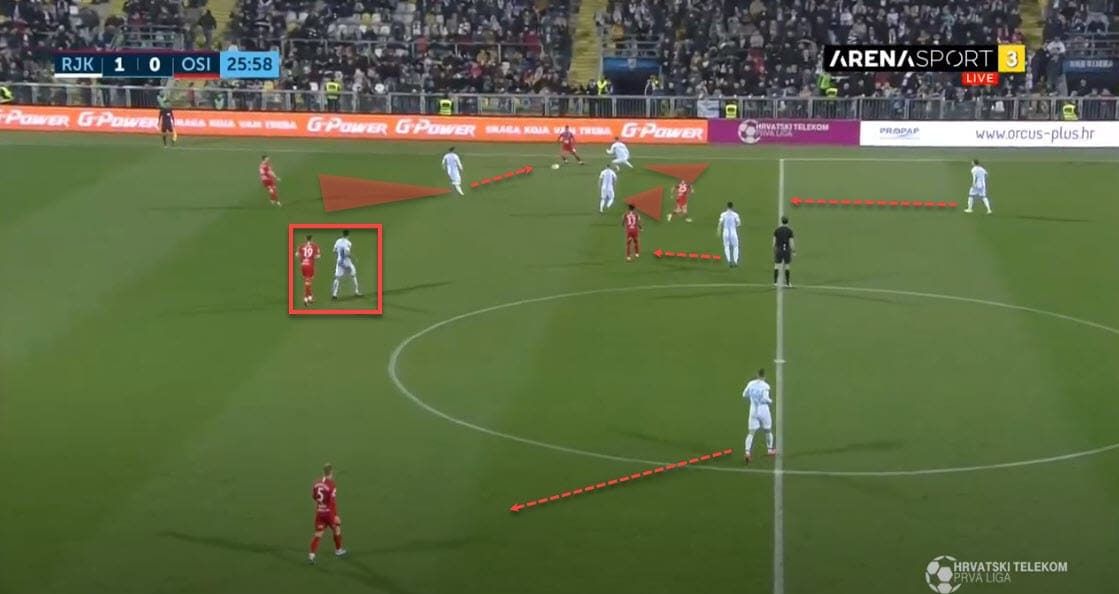
And this collapsing technique seems to be a frequent and successful part of Rožman’s tactics that once again adhere to the key principles of overloads, movement and controlled aggressiveness.
The below example against Dinamo Zagreb demonstrates all of that perfectly. The ball is recycled out wide, Rijeka’s press is activated and in a matter of moments, the blue shirts are outnumbered 6v4.
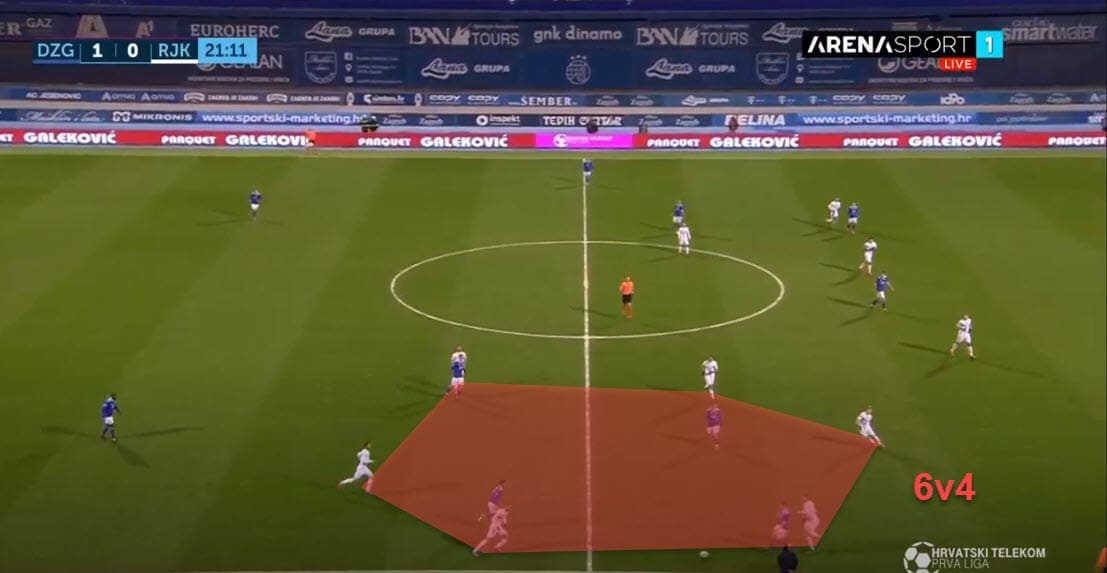
But we should also make note of the positioning of Rijeka’s players when those types of collapses happen. The forwards are always in the opposition’s half and are often joined by an additional player for support, just in case defence can be quickly turned into attack.
Both of the examples above follow that same structure and both had the potential to turn into a good transitional attack. Of course, apart from the fact that their forwards are positioned higher up the pitch, Rijeka’s compactness also plays a role in ensuring that strategy works.
The image below shows a great example when the white shirts actually scored against Hajduk through those exact tactics. The press forces the Split side to loft the ball towards their forwards but the aerial duel is lost and Rijeka regain possession quickly.
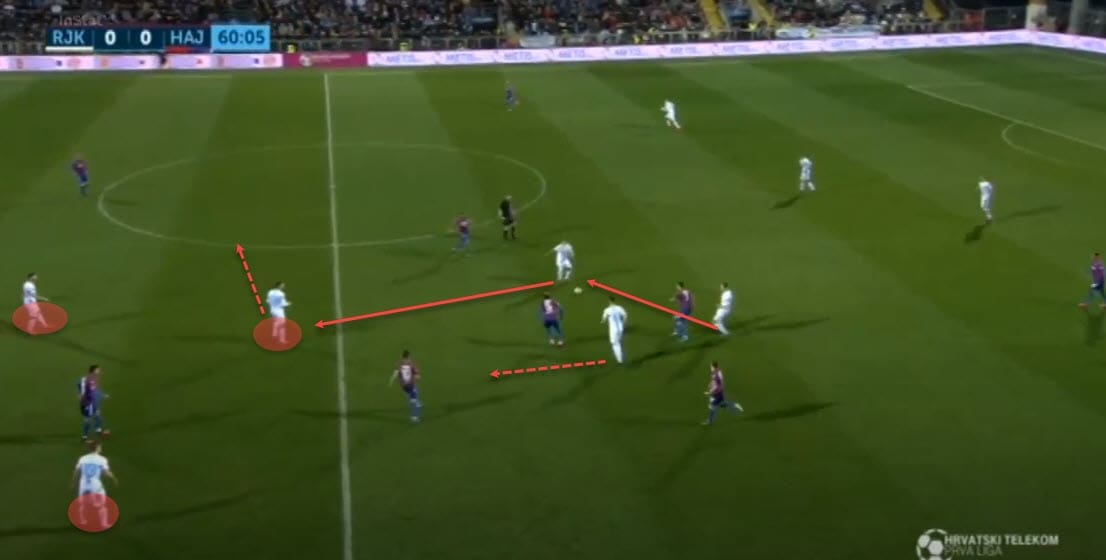
With multiple options close by and available, and with enough support up front, they can cut through Hajduk’s lines with ease and eject their players into the final third and eventually into the box to score.
Final remarks
Simon Rožman is doing a brilliant job at Rijeka so far. The team has a distinct identity and they are playing an entertaining and effective brand of football over in the 1. HNL. The title race of 2019/20 might be all but over but that doesn’t take anything away from his tactics and the system he has in place.
The future for Rijeka looks quite bright. Make sure to join us again as we continue our analysis of their key players, starting with Antonio Čolak. Stay tuned.






Comments